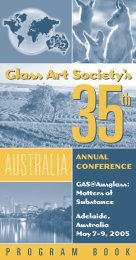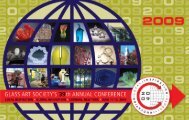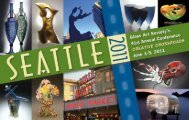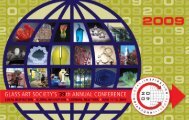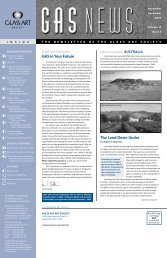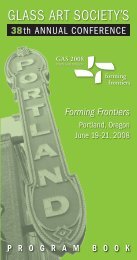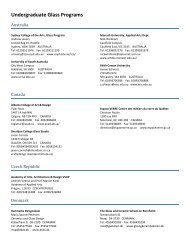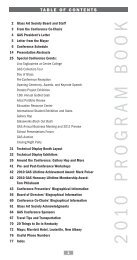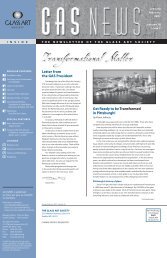GASNews October/ November 2011 Volume 22 ... - Glass Art Society
GASNews October/ November 2011 Volume 22 ... - Glass Art Society
GASNews October/ November 2011 Volume 22 ... - Glass Art Society
You also want an ePaper? Increase the reach of your titles
YUMPU automatically turns print PDFs into web optimized ePapers that Google loves.
Tavares Strachen at Pilchuck (Russell Johnson photo)<br />
Magdalene Odundo, with David Walters (left) and Ethan Stern (right) at Pilchuck (Russell Johnson photo)<br />
broadening his horizons by working with<br />
a material that was so foreign to him.<br />
He found Pilchuck, as many others have,<br />
a magical place hidden in the woods, a<br />
place where you can think something up<br />
and it somehow materializes (and, as he<br />
so enthusiastically stated, where the food<br />
is good, too). It is of course Pilchuck’s<br />
glassworkers who function as assistants<br />
that translate the ideas, designs and<br />
concepts into something physical.<br />
McQueen ultimately found the furnace too<br />
hot and casting only somewhat interesting;<br />
it was actually a glass plate and piece<br />
of string that captured his attention and<br />
resulted in success.<br />
McQueen was introduced to the idea of<br />
going to Pilchuck by Kate Elliott (formerly<br />
of Elliott Brown Gallery, Seattle) and<br />
completed the residency alongside his<br />
partner, Margo Mensing (also a fiber artist<br />
and a Pulitzer-prize winning poet-laureate)<br />
with whom he shared a studio while there.<br />
Of the artists discussed, Jim Butler<br />
is probably the one whose work underwent<br />
the most dramatic change after his<br />
residency at Pilchuck. Butler completed<br />
his residency in 2005 but his introduction<br />
to glass came much earlier. A selfdescribed<br />
painter, he studied at Rhode<br />
Island School of Design, where he was<br />
familiar with their well-known glass<br />
program. In the late 1990s, he began to<br />
notice that his work emulated properties<br />
of transparency. Wanting to capitalize<br />
on this aesthetic, he looked around for<br />
someone to fabricate work in glass for<br />
him; eventually he realized he wanted to<br />
develop the skills himself.<br />
Butler was not unfamiliar with the<br />
people in the glass world. He went<br />
to school with Peter Drobny (former<br />
designer at Steuben) and Hank Adams<br />
(Wheaton<strong>Art</strong>s) and was friends with John<br />
Childs (Vermont) and Deborah Czeresko<br />
(New York). Still, learning glass, he says,<br />
was like falling down the rabbit hole into<br />
a wonderland of glass.<br />
Pilchuck happened at exactly the right<br />
time and place for him and was the single<br />
most influential event in his professional<br />
career. There, he collaborated with<br />
Czeresko and Jill Reynolds on his City of<br />
Your Dreams project and learned how to<br />
transfer images to glass from Mark Zirpel<br />
(University of Washington) and Brian<br />
Bolden (Minneapolis). He recently took<br />
these skills to The <strong>Glass</strong> Factory at Kosta<br />
Boda in Sweden to make work using highfire<br />
decals. Butler responded immediately<br />
to his residency at Pilchuck by applying<br />
the following year for a Hauberg Fellowship<br />
(another Pilchuck program) with Rebecca<br />
Cummings and Zirpel. Today, Butler<br />
continues to work in both paint and<br />
glass, making paintings of his sculptures<br />
as well as sculpting his paintings out of<br />
glass. Butler says that he has never had a<br />
language problem with anyone who works<br />
in glass because both are based on optics<br />
and suspended colors. His City of Your<br />
Dreams project, a micro-environment that<br />
was 1,000 square feet and two stories tall<br />
(at 1/4 inch to 1 foot scale), was realized<br />
again at Middlebury College where he has<br />
taught since the 1980s. He worked on the<br />
Middlebury project with Reynolds, Adams,<br />
Czeresco and Childs.<br />
AiRs residents for the summer of <strong>2011</strong><br />
include photographer and film maker<br />
Catherine Chalmers. Chalmers is an artist<br />
9



